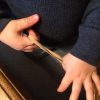How can I tell that a conversation with my child is the kind that helps him learn?
Every conversation is different–what kind of conversation helps learning? Fortunately, one important quality also happens to be easy to recognize: conversational turns. Researchers tell us that conversational turns or back-and-forth exchanges are at the root of what makes a conversation valuable when it comes to building your baby’s brain.
Your child speaks, and you respond–but not with just, “Uh huh.”
Your best reply to your child:
- Shows you heard and understood what he said
- Is warm and caring
- Is framed to invite another reply
Harvard researchers call this a serve and return interaction. (Tennis or volleyball, anyone?) In tennis one player serves the ball, and the other player returns the ball over the net. Your child speaks, and you answer. What your child offers in his “serve” changes the way you give the “return.”
What a baby brings to the conversation may not be words. A coo, gurgle, smile, a glance in a certain direction, or excited arms movements are all baby serves to be answered by the parent. Your return is a smile with a direct look and words to show you understood.
It makes you happy to see your big sister come in the room, doesn’t it?
When a tennis player makes a habit of swinging his racquet without paying attention to where the opposing player hits the ball, it’s not much of a game. It will come to an end pretty fast. Being on the returning side requires adjusting your position. In a conversation with a young child this means watching where his attention is going and being ready to respond accordingly. Your return is also calculated to invite another return from your child. This is where the tennis analogy breaks down–you WANT your child to give another response to you. The win in the game of parent-child conversation is multiple returns, not putting the ball out of reach.
Why is serve and return conversation important?
Babies and young children are busy with the critical work of building the brain architecture that will serve them throughout life. Billions of neural connections are formed across different areas of the brain. (Harvard, Center on the Developing Child). A strong foundation of brain architecture prepares a child to make the most of later learning experiences.
The serve and return interactions between a very young child and an adult are an important contributor to how these connections develop and the shaping of brain architecture.
The fact that parents can influence brain architecture is good news–great news! All parents want to give their children every possible advantage to reach their greatest potential. Regular conversational turns is a powerful brain-building tool all parents can use.
Reference
National Scientific Council on the Developing Child (2007). The Timing and Quality of Early Experiences Combine to Shape Brain Architecture: Working Paper No. 5. Retrieved from www.developingchild.harvard.edu.




